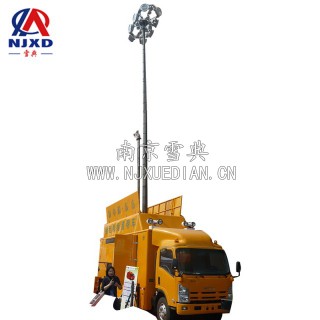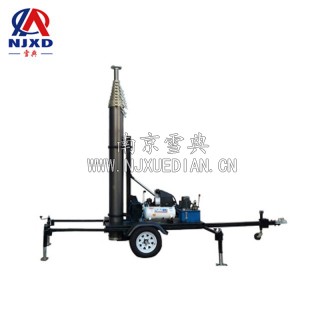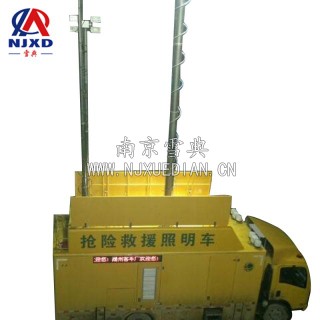NEWS
Large mobile lighting lift lighthouse trailer telescopic bracket
Time:2020-07-23 View:

Moving lighting trailer lifting rod is an important part of large lifting lamp, generally there are 3 meters, 4 meters, 5 meters, 8 meters, 10 meters and other different heights to choose from. If customized, the height can be 1-30 meters. According to the weight of the trailer, electric and manual methods can generally be selected. Some devices can also implement internal routing to meet the needs of different users, and customers can put forward your ideas. We will provide solutions 24 hours a day.
Features of the introduction of the whole vehicle of the lift trailer type lighting truck: intelligent integrated controller; External power socket; More conducive to heat dissipation of the machine; High quality Aviation plug that is convenient to connect; Automatic locking after lifting; The controlled light pole rotates 360 degrees.
Technical parameters of lift trailer Illuminator: zy06
Model ZY-1000B
Generator set EC6500CX
Rated power 5.0KW
Rated voltage 220V
Tank capacity 25L
Continuous working hours: 9hr
Power X bulb 1000W * 4
Lamp holder operation 4 sections lift
Lamp holder telescopic 2000-5600
Overall dimensions 1200*730*2000
Inclination <10 degrees
Wind resistance <level 6
Net weight 140KG

Wind resistance energy-mast wind resistance energy and calculation method
1) understanding of wind resistance of mast
Wind resistance of mast is one of the important technical indexes of mast products. Every customer wants to know how much wind the mast they use can withstand after the load is installed, but at present, almost no one can answer this question accurately. This is because the wind resistance of the mast can be determined by the following three factors:
Material and structure of A mast
Use height of B Mast
C weight, volume and shape of load
Under the condition that the above three conditions are clear, to obtain the index of specific wind resistance Energy, the following three methods can be used:
(1) theoretical calculation means using finite element analysis and other methods.
(2) the simulation experiment converts different levels of wind power into wind pressure, and then uses physical method (tension meter) for testing.
(3) in the wind tunnel experiment, the mast and load are placed in the wind tunnel to simulate the wind speed for testing.
Among the above three methods, the third method can provide a value close to the actual value. However, the cost and conditions of wind tunnel experiments are very high. For example, if a 18-meter-high mast with load is used for wind tunnel experiments, is there such a large wind tunnel? Can I do it? How much does it cost? It's all a difficult problem. Therefore, for mast manufacturers, the wind resistance index of the mast can only be provided by the first two methods mentioned above.
2) Calculation method of mast wind resistance energy
(This calculation method is the theoretical calculation formula given by our company when the mast is not loaded according to the material, structure and height of our company's mast, which is for reference only.)
For example, the wind resistance performance of the lifting rod is calculated A4-270-2300-7600, and the benchmark wind speed is 100 km/h.
1. Technical conditions
1.1. The benchmark wind speed of lifting rod design = 100 km/h ≈ 28 m/s
1.2. When ▽ = 28 m/s, estimate the wind resistance D that the lifting rod can receive.

2. Wind resistance calculation
2.1 bending section coefficient
Since the bottom of the top pipe is the weakest part of the mast, and the bending moment is also relatively large, as long as the 202mm OD pipe can be used normally, the whole mast can be used.
202mm od bending section coefficient
w=πd2/32 ﹛1-﹙do/d ﹚4﹜=3.14×2022/32 ﹛1-﹙190/202 ﹚4﹜=181332mm2
2.2 gust coefficient
The so-called gust coefficient Kg is the ratio of the maximum instantaneous wind speed V2 to the average wind speed V2 in the observation time. It follows the observation time, average wind speed, terrain, ground roughness, factors such as the return period of the benchmark wind speed are related. Generally, Kg is between 1.2 and 1.5. Here, take Kg = 1.3.
V2=▽Kg=28×1.3=36.4m/s
2.3 Reynolds number of different diameter sections of lifting rod
2.3.1 Reynolds number
R2=V2d/V= 36.4×0.202/0.15×10﹣4=4.9×103
V-air motion viscosity coefficient, 0.15 × 10-4m 2/s
d-pipe diameter
2.3.2
The resistance coefficient CD of the lifting rod is determined by the variation range of Reynolds number of each section of the lifting rod.
Because the slenderness ratio of the lifting rod is large and its appearance is very smooth, we can regard the lifting rod as a smooth two-dimensional rod. The following figure shows the relation curve between the resistance coefficient CD of the smooth two-dimensional cylinder and Reynolds number Re.
As can be seen from the curve, the Re range of the lifting rod is exactly in the area where CD = 1.2.
2.4 wind resistance at the top of the lifting rod
D=CD·2/2PV22dlKg2
= 1.2 × 2/20 × 36.42 × 0.202 × 1.7 × 1.32
=57.67kg
2.5 strength check
σmax=Mmax/W=37.4×20×27×2000/20222=5.4Mpa
Under 6063-T6, σ = 205Mpa, to ensure safety, take σ = 160Mpa
Because σ max<σ, the mast can withstand the wind speed of 100 km/h. Under the condition of mechanical self-locking structure, the wind force borne by the mast can multiply and can withstand the wind speed of 11 levels.

3) methods to improve wind resistance of mast
In the case of using the existing mast, to improve the wind resistance of the mast, the following methods can be adopted:
1) lift the mast according to the weather conditions. When the wind is strong, lower the mast. When it is windy, raise the mast.
2) use wind-resistant fiber rope. The correct and timely use of the fiber rope can greatly improve the wind resistance of the mast.
3) choose other mast specifications of our company
v:shapes="_x0000_i1036">
5. Load performance-mast load calculation method
6. Maintenance Performance-mast height maintenance method
The pneumatic lifting mast realizes the stretching movement by injecting and discharging compressed air into the inner cavity of the mast. The maintenance of its height is realized by storing a certain amount of compressed gas in the cylinder body, which is called "pressure maintaining" for short ".
To keep the pressure, it is required that the mast has good sealing performance and the control valve of air source input and output has good sealing performance. However, theoretically, no matter how good the sealing performance is, the air will leak slowly, which is the so-called "micro leakage" phenomenon. Therefore, maintaining height and maintaining pressure is only a relative concept. If you need to maintain a certain height for a long time, you need to continuously replenish air, which can be achieved through control technology. If the pressure detection device is installed on the gas path, when the air pressure is lower than a certain value, start the air pump to replenish the air. In addition, another method can be adopted to maintain the mast height, namely "mechanical maintenance". See the self-locking mast section.
(Pressure maintaining formula) pressure formula
Calculation Formula of thrust in cylinder
F=1/4πd2P
F is the thrust generated by gas (N)
d is the diameter of the mast piston (cm)
P is working pressure (MPa)

CATEGORY
NEWS
- Detailed analysis and introduction of technical description of pneumatic lifting rod products
- Large mobile lighting lift lighthouse trailer telescopic bracket
- Emergency trailer lift bracket with customizable trailer length
- Comparison between Pneumatic lifting bracket and hydraulic lifting bracket
- Classification mode of pneumatic lifting bracket and special oil for air compressor